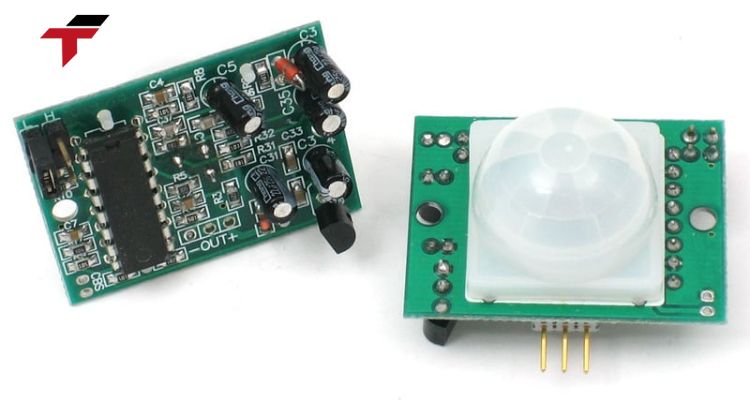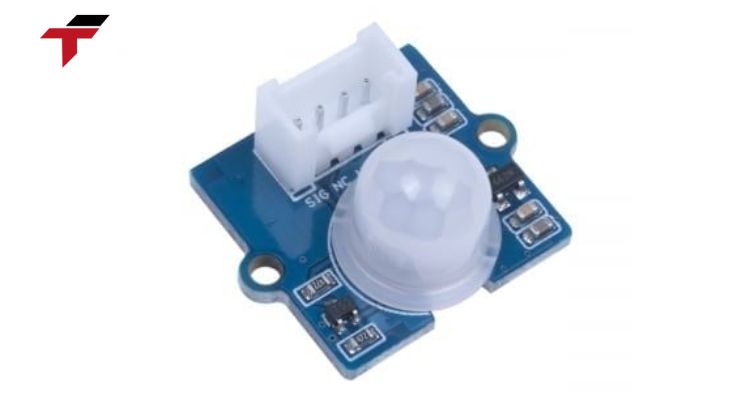A motion sensor is an electronic device that detects movement or physical presence within a specified area. These devices operate on the fundamental motion detection principle of converting a detected physical change (like heat, sound reflection, or radio wave distortion) into an electrical signal.
In the context of industrial settings, motion sensors are a vital component of modern industrial sensing technology. Their primary function is to provide real-time input to automation systems such as triggering safety shutdowns, controlling lighting/HVAC, monitoring conveyor flow, or enabling object tracking for quality control. Beyond simple detection, advanced motion sensors offer high-precision measurements crucial for maintaining safety and efficiency in complex automated processes.
How Motion Sensors Work in Automation Systems
In automation systems, motion sensors serve as the “eyes” and “ears” of the control architecture.
- Sensing: The sensor detects movement in its environment (e.g., a person entering a hazardous zone, a product on a conveyor, or an Automated Guided Vehicle (AGV) approaching).
- Signal Conversion: The sensor’s core component converts this physical change into a proportional electrical signal (often a binary ON/OFF signal or an analogue value).
- Data Input: This signal is transmitted to a Programmable Logic Controller (PLC) or other control system.
- Action Trigger: The PLC processes the input and executes a pre-programmed action, such as stopping a machine for safety, diverting a package, or turning on a light.

How Motion Sensors Work in Automation Systems
Types of Motion Sensors Used in Industrial Environments
Industrial environments demand robust, high-accuracy sensors, leading to the use of various technologies tailored for specific conditions.
- PIR (Passive Infrared): Detects changes in infrared radiation (heat). Excellent for detecting the presence of people or machinery with a significant heat signature. Widely used for security and energy management.
- Ultrasonic: Emits high-frequency sound waves and measures the time-of-flight of the reflected echo. Highly effective for non-contact sensing, level detection, and detecting movement in complex, non-line-of-sight areas.
- Microwave Radar: Emits microwave pulses and detects motion by measuring the frequency shift of the reflected waves (Doppler effect). Known for its long detection range and ability to detect through non-metallic barriers, making it ideal for robust microwave motion detection in large, unobstructed areas.
- LiDAR (Light Detection and Ranging): Uses pulsed laser light to measure distances and create detailed 3D maps of the environment. Critical for high-precision tasks like robot navigation, collision avoidance, and volumetric measurement in warehouses.
- Optical (Photoelectric): Uses a beam of light (visible or infrared) and a receiver to detect an object that breaks or reflects the beam. While primarily proximity sensors, they are fundamental for detecting movement and position along a line.
- Dual-Technology: Combines two sensor types (e.g., PIR and Microwave) to cross-verify detection and significantly reduce false triggers caused by environmental factors.
Key Components and Sensing Mechanisms
All industrial motion sensors consist of a few core elements:
| Component | Function |
| Sensing Element | The part that physically interacts with the environment (e.g., a pyroelectric crystal in an infrared sensor module, an ultrasonic transducer). |
| Signal Processor | Amplifies and filters the raw electrical signal from the sensing element to isolate the motion event. |
| Output Circuit | Converts the processed signal into a usable format for the PLC (e.g., relay output, analog current loop, or digital fieldbus message). |
| Lens/Antenna | Focuses the sensor’s field of view to define the detection range and pattern, which can often be adjusted via sensitivity settings. |
Motion Sensors in Industrial Automation Ecosystem
Motion sensors play a vital role in the industrial automation ecosystem, supporting safer, smarter, and more efficient operations. Their adoption spans multiple industries, enhancing productivity and enabling advanced Industry 4.0 capabilities.
Adoption Across Key Industries
Motion sensor adoption in Malaysia is a key driver of the nation’s push towards Industry 4.0.
- F&B Manufacturing: Used for presence detection on conveyor belts, automated packaging line speed monitoring, and personnel safety around high-speed machinery.
- Oil & Gas: Employed for perimeter security, flare monitoring (using IR/thermal sensors), and safe zone detection in hazardous environments where traditional contact sensors pose a risk.
- Palm Oil Mills: Crucial for machinery monitoring, detecting blockages in processing lines, and ensuring employee safety around heavy, rotating equipment.
- Automotive: Integrated into assembly line robotics for precise component placement and safety curtain creation to protect human operators.
- Warehouses & Logistics: Fundamental for optimising automated warehouses, managing high-bay storage access, and ensuring conveyor safety.
Motion Sensors in Warehouse Automation and ASRS
In modern logistics, motion sensors are indispensable. They are used in ASRS (Automated Storage and Retrieval Systems) to confirm the precise positioning of loads before retrieval, and for collision prevention in narrow aisles. On conveyors, they detect object presence, spacing, and jam conditions, ensuring smooth material flow and maximizing throughput.
Palm Oil Mills and Heavy Industry Applications
Given the challenging, dust-filled, and hot environment of palm oil mills, robust sensors are required. Microwave and ultrasonic sensors are often preferred for mill machinery monitoring to detect movement in high-vibration areas. They are critical for hazard detection like unauthorized entry into dangerous machine pits – enhancing equipment safety in Malaysia’s heavy industries.

Motion Sensors in Industrial Automation Ecosystem
Future Trends of Motion Sensors in the Automation Sector
The automation sector is rapidly evolving, and motion sensor technologies are at the forefront of this transformation. Emerging trends are redefining accuracy, efficiency, and sustainability across modern industrial environments.
AI Vision and Sensor Fusion Technologies
The future involves highly integrated systems using multi-sensor fusion. This combines data from different sensor types (e.g., a camera, a LiDAR, and an ultrasonic sensor) to create a more comprehensive and reliable picture of the environment. AI detection models analyze this merged data, moving beyond simple detection to highly accurate object recognition, trajectory prediction, and complex pattern analysis.
Edge Computing for Real-Time Motion Processing
To handle the massive data generated by vision and LiDAR sensors, edge computing is becoming vital. Sensor data is processed locally on the device or a nearby industrial gateway, enabling real-time processing and decision-making with extremely low latency. This is essential for safety-critical applications like high-speed robotics and AGV collision avoidance.
Sustainability Trends in Manufacturing
Motion sensors are increasingly playing a role in green automation. By accurately detecting occupancy and machine status, sensors enable intelligent control of lighting, ventilation, and machinery operation. This leads to substantial energy savings, driving the adoption of energy-efficient sensors as manufacturers prioritize sustainability goals.
How to Choose the Right Motion Sensor
Choosing the right motion sensor is crucial for achieving accuracy, reliability, and long-term performance in industrial environments. With Malaysia’s demanding tropical conditions, businesses rely on trusted partners like Flextech to recommend, supply, and integrate suitable motion sensing technologies for any application.
Why Flextech is the trusted partner for motion sensor selection
- Expert Engineering Support: Flextech provides application-based consultation to help you select the correct detection range, sensitivity, and accuracy level.
- Industry-Proven Sensor Portfolio: Access high-quality, IP-rated, humidity-resistant, and vibration-proof motion sensors suitable for Malaysia’s manufacturing and palm oil industries.
- Seamless System Integration: Flextech ensures smooth compatibility with PLC, SCADA, and HMI systems, including IO-Link, Profinet, EtherNet/IP, and other industrial protocols.
- Compliance & Standards Knowledge: Flextech supplies sensors that meet SIRIM, MS, and safety-related DOSH requirements, ensuring regulatory compliance for industrial facilities.


